How to build a people analytics strategy in your company

Would you like to build a people analytics team and implement people analytics strategy in your company but you don’t know how to get started? This guide will explain the whole process step by step.
HR managers are sitting on a goldmine – even if they do not always realize it. All the data they collect throughout an employee’s lifecycle in the company can be business-relevant and help management make informed decisions. The biggest challenge is turning that raw data into meaningful insights.
That’s exactly what people analytics is for.
But how to start people analytics?
In this article, together with people analytics experts, Tim Peffers and Mateusz Karpiński, we will guide you through the key steps of implementing people analytics strategy in your company and answer key questions about starting it.
Table of contents:
INTRODUCTION
PART I
PART II
PART III
What is people analytics?
Discover how you can unlock the power of people analytics without HR analyst onboard.
People analytics definition
People analytics – also called HR analytics or workforce analytics – is the process of collecting and analyzing workforce data to to improve business outcomes. In other words, people analytics uses metrics about your workforce to tell meaningful stories that can impact your business. It gives your business a strategic direction based on evidence, rather than guesswork and intuition.
Until recently it was associated with large enterprises. Today, more and more mid-sized companies are investing in people analytics solutions and data-driven HR. As you will read further in the text, there is really no minimal size of a company to start working with data in HR. A people analytics platform can be very efficient both in a team of 50, as in the team of 5000.
People analytics platform
What exactly is a people analytics platform and how does it work?
It is a software that integrates all your data points scattered across systems and imports them into one, easy-to-use platform. Your data about employees is visualized and presented in the form of accessible dashboards. With a people analytics platform, you can have access to various HR metrics and data points, such as:
- Open positions
- Recruiters efficiency
- Time to hire
- Time to fill
- Time to onboard
- Headcount change in time
- Employee profiles
- Compensation
- Cost of benefits
- eNPS by team, department and project
- Total turnover
- Early turnover
- Turnover by leader
- Regrettable and Non-regrettable leaves
- Revenue per employee
- Employee performance
- Goal tracking
- Performance
- Engagement
- Productivity
To get an idea of how a people analytics dashboard looks like, see one of the dashboards from the Human Panel platform:
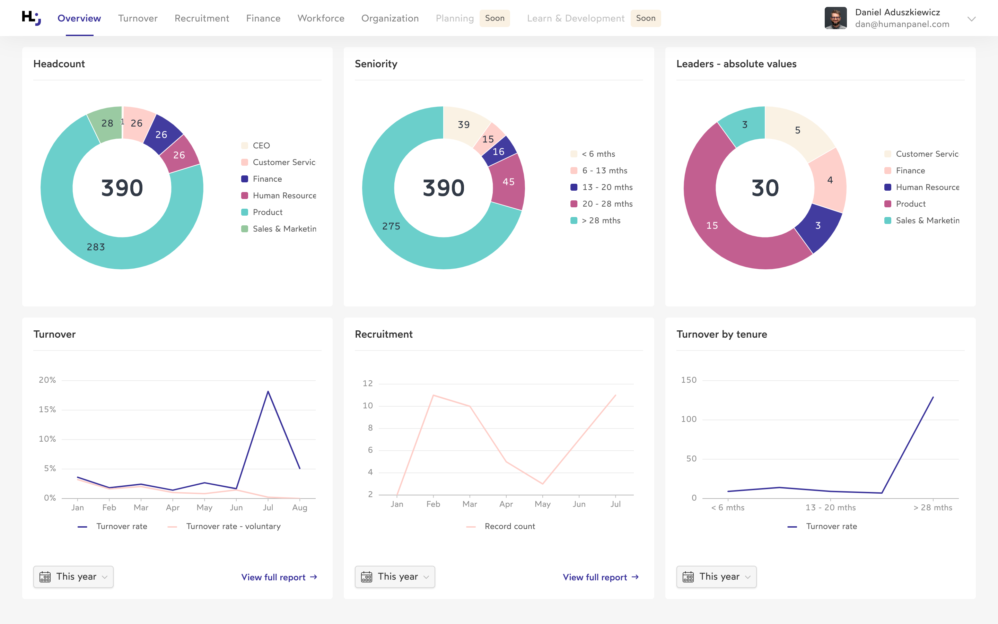
See a complete list of Human Panel features and HR metrics.
The benefits of people analytics
You might be wondering what the real benefits of people analytics are, and it’s a fair question to ask. Your colleagues at HR could say it adds value to your business, but what does that mean exactly? What is the true, unique value proposition of people analytics? What tangible insights can it deliver?
Let us take a look at some of the benefits that people analytics can provide:
- Getting rid of frustration and guessing. People analytics is a science – not a gut feeling – that supports your decisions.
- Making you alerted about people issues you might have otherwise missed, such as higher turnover in a particular group or team.
- Helping you close the gap around business acumen, so HR can finally build a strategic vision instead of spending time on operational tasks.
- Helping you manage your HR through measurable KPIs and predict the ROI of your HR investments.
- Showing you what drives human capital excellence and ROI and how to measure and predict those drivers.
- Making sense of your employee data – you know what to focus on and how to understand the insights you get to make a better sense of data and act on it.
In terms of HR processes, people analytics helps you in:
- Better employee retention and lower turnover.
- Identification of the best sources for quality candidates.
- Better structuring of your onboarding process to reduce time to productivity.
- Increase in the efficiency of your recruiting funnel.
- Achieving fair compensation.
- Optimizing training models and assessing employee learning capabilities.
- Increasing diversity within the organization.
- Facilitating succession planning.
- Improving productivity.
Crucially, people analytics is a tool that helps achieve the desired outcomes, not the solution itself. Context is everything. There is no magic formula that will solve each of your company’s problems. HR metrics will give you answers – but you need to ask the right questions first. If you adopt a question-based mindset, you’ll be on the right track to working with data in HR.
Some leaders fear though that it’s hard to begin working with data in HR, especially if you start from scratch. Others are not sure when to start working with people analytics and might think their companies are too small to think about implementing it. We’ll try to answer these doubts and show you how you can implement a data-driven approach in your HR.
Part I
8 steps to start people analytics and working with data in HR (from scratch)
In this part, we will examine how to start working with data in HR, together with our people analytics expert Mateusz Karpiński.
DOWNLOAD THIS CHAPTER AS A FREE PDF
Step 1: Identify the challenge
To begin your people analytics journey, you need to understand what business problem you are trying to solve. Is it a high turnover rate? The rising cost of recruitment? Or perhaps declining employee satisfaction?
“These challenges should be identified in a conversation with the business leaders, the owners or other stakeholders, depending on the size of the business,” says a people analytics expert Mateusz Karpiński.
Ask stakeholders what they are struggling with. What do they want to improve or achieve, and what do they expect? Sometimes they will not give you a clear answer and just say: “we do not win enough projects.” Keep on digging, why – is it because they don’t have enough business developers? Or maybe it’s about their competencies?
Example
A manager of Team X says, “My employees are leaving the company. I cannot deliver the expected results because the turnover rate is too high and I cannot replace those who leave with new employees.”
That can be the starting point for a discussion. Now, you should think about why this issue is important and what impact it has on your business. You should ask some follow-up questions:
- How does this problem affect the team’s performance?
- What results would you like to achieve?
- How are these outcomes likely to impact the organization?
- Who will be affected by these outcomes?
Step 2: Review the data sources
Once you have identified the problem, ask yourself what kind of data you have to illustrate it and where you can find it. Data sources may include:
- Employee demographic data.
- Data on position, seniority, compensation, tenure, time since last promotion, learning and development opportunities, etc.
- Employee satisfaction surveys.
- Feedback from one-on-one interviews and exit interviews.
- Insights from leaders and managers.
If you are missing a relevant piece of information, consider how to gather it. Can you ask other stakeholders and check if they have any relevant data? Do you need to conduct another survey or hold another meeting with the team? Fill in some gaps in basic demographic information? What other type of data might be useful in this situation?
Step 3: Gather the data
Once you know what your data points are, you can collect and organize them in one place. This way, you start building a database that will be a pillar for your data ecosystem. You can start by organizing the information in a simple spreadsheet, or you can opt for one of the specialized people analytics tools.
Remember that “data” does not just mean raw numbers, metrics like payroll and eNPS. A conversation with the employee about their performance is also an important source of data. The same goes for insights from managers and employees.
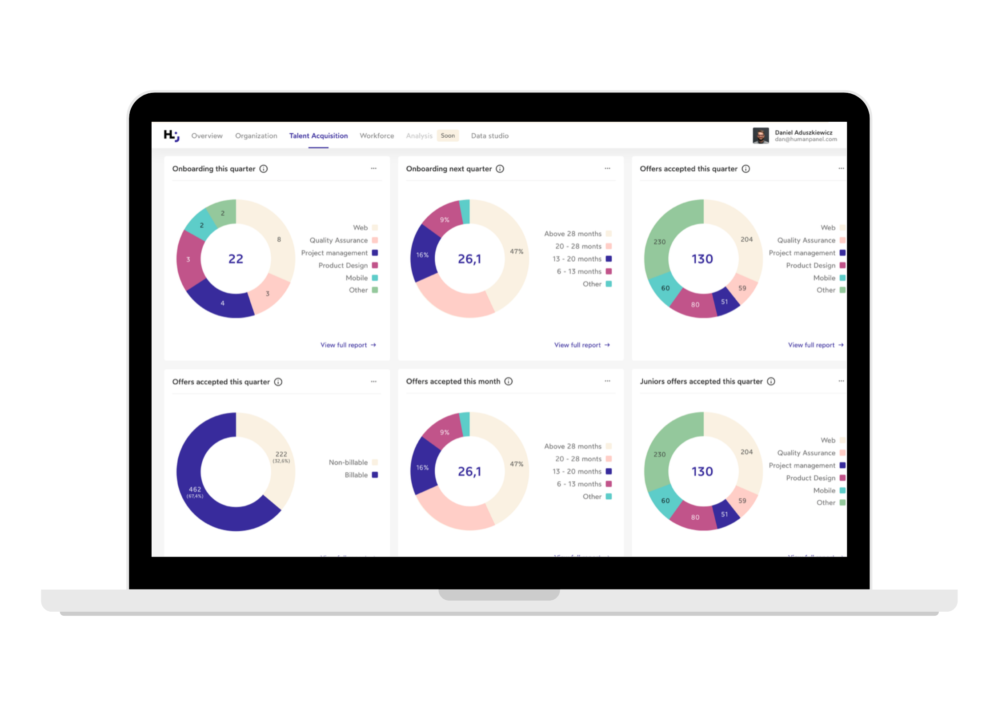
Step 4: Clean the data
The next step is data cleansing. In this phase, you need to sort your information and remove the data points that are not relevant or of insufficient quality. You should remove any incorrect or inconsistent data as well as extreme outliers.
Example
For your employee satisfaction survey, you use the employee ID as the identification point. For exit interviews, you use first and last names, making it difficult to compare. How do you determine who is who? Cleaning the data means you always use the same identification metric.
Another issue is how you collect the data. Sometimes you use Google Sheets, other times it could be e-mail or a dedicated survey platform. In each of these cases, the data may come in different formats, and even different date formats can cause unwanted chaos.
Step 5: Analysis
To perform an insightful data analysis, break it down into smaller steps.
Defining the objective
Focus on the goal you want to achieve and the question you want to answer. Analyze only the data that is truly relevant to your investigation.
For example, if you are investigating why employees leave Team X, you can exclude those who retire from your analysis.
Descriptive analysis
Descriptive analysis answers the question “what happened”. It is a retrospective analysis that reports on past events and serves as the first level of your investigation.
Descriptive analysis shows you a synthesis of raw HR metrics such as:
- How many people left Team X in July.
- What position these people held in the company.
- What age they were.
- How much they earned.
- Who their supervisor was.
- What learning and development opportunities they took advantage of.
- How long it has been since they were last promoted.
- What their performance was.
It is important to understand that this is only the first level of data. To run a thorough analysis, you will need to add information about the employees who have left the company. The sources for this can be surveys, polls, and exit interviews. This kind of information can deepen your knowledge and answer the following questions:
- What were the reasons employees gave for leaving?
- How high was their level of engagement and satisfaction?
- What kind of feedback did they give about the company?
- How did they rate their managers?
- Where did they leave the company?
These questions are not exhaustive, but they highlight the mindset you should have. The key is to keep digging deeper and asking “why”. That way, you have a chance to get to the root of the problem.
Diagnostic analysis
Now it’s time to correlate the data. Diagnostic analysis shows you the relationships between the data and answers questions like:
- What is the turnover in Team X related to? Is it related to gender, age, position, compensation, time since last promotion, or the change of a leader?
- How does it look on the timeline – is it related to changes in the way you work (remote/hybrid) or are external factors involved, such as intense recruiting by your competitors?
- How did the employees who left you respond in surveys and interviews? Were there any leading indicators of their dissatisfaction?
Again, this is by no means an exhaustive list, but it will give you a general idea of what to expect from a diagnostic analysis.
Predictive analysis
Predictive analysis uses known data to answer the question “what will happen” – making predictions about future events. It is primarily used in planning, but can also help predict who is most likely to leave your company. Using algorithms and machine learning, it shows you who is at risk and which areas you should address first.

Step 6: Evaluation
Before you start turning your insights into actions, you need to evaluate them and decide which ones are most relevant and which ones may be just “noise.” Are there any surprises? Or has your hypothesis just been confirmed? Do you see the need for additional analysis?
It’s also a good moment to structure and organize your conclusions to get ready to present them to the key stakeholders.
Step 7: Communication
Translating the insights and explaining their meaning is an important step – you need to decide who should be told about your key findings and why they are important to the business.
“Hard facts rather than assumptions pave the way for a data-driven conversation with key stakeholders and elevate the position of HR. You can say, ‘I know the root cause of the problem and how we can solve it. I am not experimenting to see if something works, I have numbers to back up what I am doing,’” Mateusz Karpiński comments.
You can show that your HR decisions have an impact on the business and prove that HR is no longer about admin work or talking. It’s about making an impact and working closely with the business to optimize costs, and generate profits or savings.
Mateusz Karpiński
Step 8: Take action
Once you have the insights and have explained them to your executives, you can take action and come up with an intervention strategy. Then, it’s also important to monitor these strategies and see if they are producing the desired results. What impact are they having? Is the change visible? Are there areas where you are not having success? And why?
Tools to start people analytics
The truth is, you don’t have to perform all those tasks yourself.
Data gathering, cleansing, and integration can be time-consuming processes that need your full attention. This is where you might want to try a people analytics platform, such as Human Panel.
With us, there is no painful starting point – we import data from any source and take care of all the integrations and automations.
Data cleansing is also on us – what you get is a reliable set of qualitative insights ready to operate on. And you can be sure that your data is safe with us – we act in accordance with the GDPR legislation and ensure the highest grade of protection and control for all data.
If you want to see how it works, subscribe to our demo – it’s an entirely free and non-binding opportunity to watch people analytics in action.
Ready to start people analytics with Human Panel?
Part II
How to build a people analytics team in your company?
DOWNLOAD THIS CHAPTER AS A FREE PDF
In this part, we will take a closer look at how to build a people analytics team. What roles should you consider when building a people analytics team? What skills should these employees have and what tools can be useful in the process?
We prepared this part together with Tim Peffers, the Organization & Talent Analytics Lead in Philip Morris International and a host of “Random Walks in HR”
The essential tasks of people analytics team
The essential tasks you want to perform in your people analytics team are:
- Collecting, cleaning, managing, and storing your data.
- Generating insights from the data you collect.
- Interpreting those insights through the lens of HR.
- Explaining to all stakeholders, within HR and the wider business, why this data is relevant, what actions can be taken and how it will support the business strategy.
- Communicating the insights so that everyone can understand them.
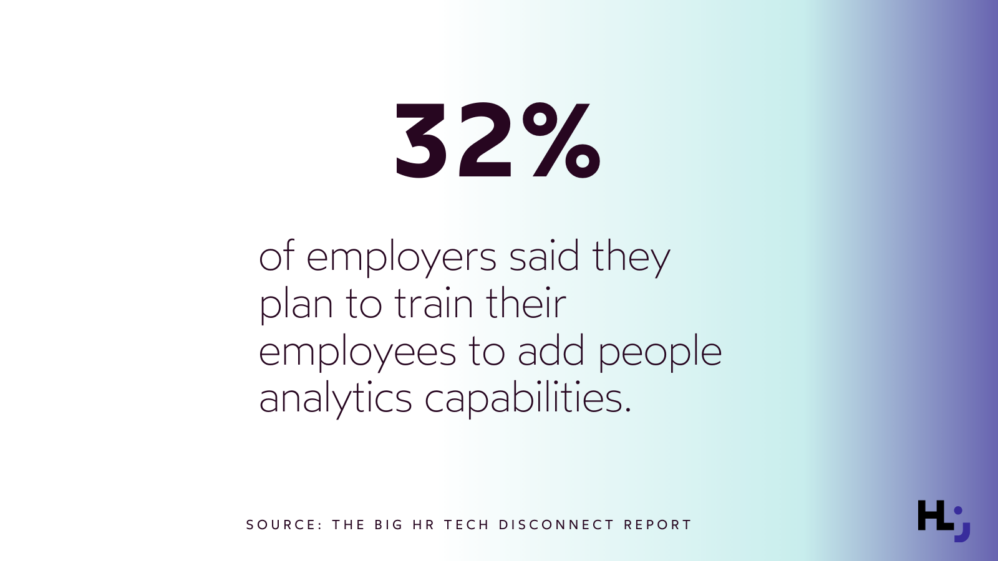
Roles and career paths in people analytics
To ensure these tasks are accomplished, you may want to find people for the following roles.
The “Specialist” career path:
- Analyst
- Senior Analyst
- Data Engineer
- Researcher
- Data Scientist
The “Manager” career path:
- Manager
- Senior Manager
- Senior Leader
The most sought-after qualifications for people analytics positions:
- Statistics
- Economics
- Mathematics
- Psychology
- Social Sciences
- Industrial and Organizational Psychology
- Empirical Research
- Labor Economics
In the case of HR, talent analytics, insights that help drive performance, retention and development, is by far the most sought-after skill for anyone seeking a career in human resource analytics.
The most in-demand technical skills for HR specialists:
- Excel
- SQL
- Python
- Data Analysis
- Data Visualization
- Data Science
“Measure the right things”
As Tim Peffers notes, people analytics skills are critical, but what’s even more important is how you want to structure your team and what tools you want to use.
“If you don’t have a dedicated people analytics platform, you definitely need someone who knows Excel and has research and analysis skills, such as data analysis. But research will not give your project its full impact. If you want to build a successful people analytics team, you need to think about the whole strategy. This includes the research but also workplace ethics, employee privacy, and the legal aspects of data collection and processing,” Tim explains.
“Make sure you are measuring the right things. Assess what kind of data you need, which is necessary and which is appropriate,” Tim adds.

92% of employees agree to having data collected about them
It is crucial that you understand why you are setting up your people analytics and make sure your employees understand it too. According to research, 92% of employees are open to having data collected about them, but only if they see a personal benefit.
If your employees see that they are getting value for their data (e.g. personal development plans, training, personalized benefits, promotion plans), they are more likely to collaborate.
Therefore, it is also important to have someone on your analytics team who can convince the rest of HR that you are doing the right thing. “We have to remember that people analytics uses information about employees. They need to know what that data is being used for and that it is for their benefit. They have to be sure that their personal data will be handled with care and caution,” comments Tim.
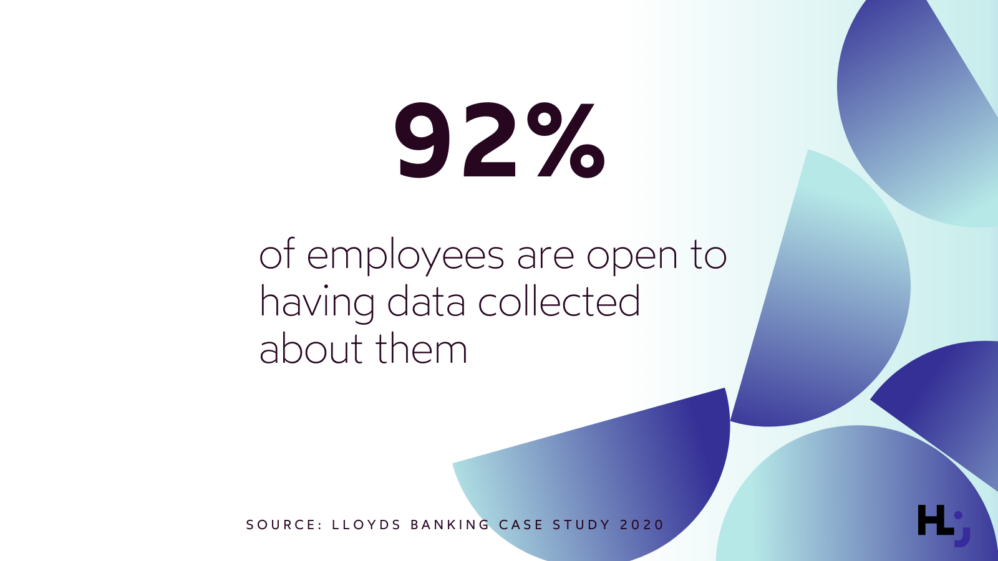
How to talk about people analytics to the business?
Tim Peffers points out that you also need people on your HR analytics team who can explain the meaning of that data to business leaders.
Your people analytics team should be both technically and humanly oriented. In addition to data scientists, you also need someone who knows what’s going on in the organization on a human level.
Tim Peffers for Human Panel
This ability to “talk to the business” is critical. Many companies already collect a lot of information about their employees, but boards sometimes do not see value in that raw data. The key is to show them how these insights can be turned into action. Knowing the reasons for turnover can help reduce it and consequently reduce the cost of filling vacancies. If you can show that the people analysis has helped save a certain amount of money, it’s a win-win for both the people analysis team and the business.
Start with a dedicated software
As he adds, building a people analytics team is a process. If you run a small to medium-sized business, you could start with dedicated software, a product manager and the support of a data science team. Then you might want to hire a data engineer to “clean” and pre-process all the raw data.
“Later, you’ll probably need an HR business partner responsible for consulting between science and business and visualizing the data so that everyone understands it. That’s a model way to go,” says Tim. “Of course, all these roles require certain skills, and then you need to decide whether you want your data scientist to have very specific qualifications or whether you use a dedicated people analytics platform” he adds.
People analytics platform vs HR analyst costs
At some point and over a certain size of a company, you will probably want to hire an HR analyst. Remember however that using a people analytics platform saves you a lot of time and money.
Hiring an HR analyst costs usually 3 times more than using our platform where all data is readable to everyone but the access is fully controlled to secure the sensitive employee data. In fact, a single tool – like the Human Panel people analytics platform – can be enough to successfully launch people analytics strategy in your company.
People analytics solution will help you know what to focus on and how to understand the insights you get to make a better sense of data and act on it. It goes far beyond simple reporting. It answers questions critical to your business and tells meaningful stories about your employees.
When you choose Human Panel, you avoid the painful starting point of data cleansing and integration. We import data from any source and you get a reliable set of qualitative insights ready to operate on.
With us, you don’t need a data scientist. All dashboards are easily accessible, which means you can share them and collaborate freely. See all HR metrics and features of Human Panel.
Learn more about the benefits of people analytics and sign up for a free demo of Human Panel.
Ready to start people analytics with Human Panel?
Download this chapter as a PDF
Part III
Frequently asked questions
In this part, together with people analytics expert Mateusz Karpiński, we’ll answer the most common questions about starting people analytics.
Question 1: At which point of the lifecycle of my organization should I start people analytics?
If you employ 40 people, you probably know all of them – their names, faces, functions. You might think you don’t need people analytics in such a small organization. You might have not even hired an HR manager yet.
Most guidelines and recommendations say that a threshold of 120-150 people marks the point of exit from a family or tribe culture to a more corporate culture. With over 100 employees, you’re probably unable to know all of them. You need some numbers to tell you meaningful stories about them – and therefore, you need people analytics.

However, even in smaller organizations, startups, and developing businesses, starting building a data infrastructure makes sense. If your company has a potential to grow, then you might want to collect information about your current workforce because once you scale up, you will have historical records about people who work or worked for you.
The key is to gather the data about your employees and keep them organized in one place. When you grow, you can think about people analytics software but then you will not have to reconstruct everything from the scratch – you will already have foundations to do that. Human Panel software is successfully used by smaller organizations who want to be data-driven and rely on science – not on hunches and gut feelings.
Question 2: Is there a minimum size of the company for which people analytics could bring value?
The truth is, people analytics brings value even in small organizations. Even if you employ only 20 people, you can track such HR metrics as:
- Source of hire. Where did these people come from?
- Cost per hire. How much did it cost me to recruit them?
- Time to hire. How much did it take me to fill in these positions?
- Applicants per opening. How many people applied for my job posting?
- Time to onboard. How long did it take before my employees started making a meaningful contribution and reached the optimal productivity?
Identifying that you had 3 candidates for a job from one source, and 5 from another and comparing the quality of those applications is already people analytics! Analyzing who has been working with you for two years, and who left just after three months (and why) is also people analytics.
Starting people analytics is like starting a healthy diet – it’s not a project you can finish after three months, forget it, and come back to old habits.
To make a meaningful change, you need to continue your journey and adopt a certain mindset. The sooner you do it, the more chances you have to succeed.
Question 3: How many people in the team do I need to start people analytics?
To find answer to this question, check out Part II – Building a people analytics team.
Question 4: Do I need an HR analyst to start?
Today’s tools make analytics easy and accessible to anyone, not just analysts. Hiring an HR analyst would cost you much 3 times more than using a dedicated software such as Human Panel platform. We offer you not only visualized data, charts, and graphs but we also give you support throughout the entire length of the subscription. Our experts are ready to help in any case – free of additional costs.

The truth is, you don’t even need an HR manager to start. You can begin with creating an HR dictionary that everyone can understand and make sure that all leaders and managers use the same definitions and the same metrics for evaluation. These little steps will help you start working with HR data without making large initial spending or hiring a dedicated staff.
Question 5: Should I have any special tools or systems to start working with people analytics?
You can start your people analytics in spreadsheets or any other system that suits you. The key is to keep data organized and in one place, granting access to all the relevant people. It’s no use storing the information on your hardware, in a hidden folder among other documents.
People analytics works best when it’s live – you need your leaders and managers working with it together.
Of course, there are tools and platforms that make people analytics even easier. If your company is rapidly growing, it would be a good idea to try a dedicated solution. The tool is there to help you but it’s a secondary matter. What’s most important is your data-driven approach to HR. Whether to start people analytics is a business decision – and you should make sure that all key stakeholders support the idea.
Try Human Panel – sign up for a free demo and see people analytics in action.
Question 6: What are the possible blockers that I can come up against?
Like with every business decision, when trying to make the one about starting people analytics in your company, you can encounter some obstacles. The most common blockers in this case are:
- The mindset of HR leaders or business stakeholders.
- The lack of data literacy in your HR team.
- The questions about data security and your employees’ privacy.
- Legal constraints.
- Ethical limitations.
If you’re afraid that your employees will be reluctant to have the data collected about them, you can always ask them what they think about it. As an employer, you gather personal data anyway – and you agree to use it only for employment purposes, such as recruiting, payroll etc.The research shows that 92% of employees have nothing against gathering data about them if they know what purpose it serves and what possible benefits it can bring. For example, it could bring better-designed career paths, more learning & development opportunities, or more personalized benefits.
If you lack appropriate data literacy skills and competencies in your HR team, you can start by making those small steps we mentioned in sections 3 and 4. If your HR team is willing to learn about people analytics, you can invest in training them.
The greatest challenge
The greatest challenge is changing the mindset. As we stated earlier, people analytics shouldn’t be treated like a “project”. A data-driven approach should be embedded in the company’s DNA, and people you work with need to be willing to work with data.
The best way to convince those who are reluctant is to show them how insights from people analytics work in action. With the right analytics, you can determine, for example, any money leaks in your company’s budget – and how to prevent them from occurring. You might discover that pricey job ads don’t bring you any valuable candidates, and that your best recruitment sources are somewhere else. This helps you save money and show tangible results in just a few weeks.
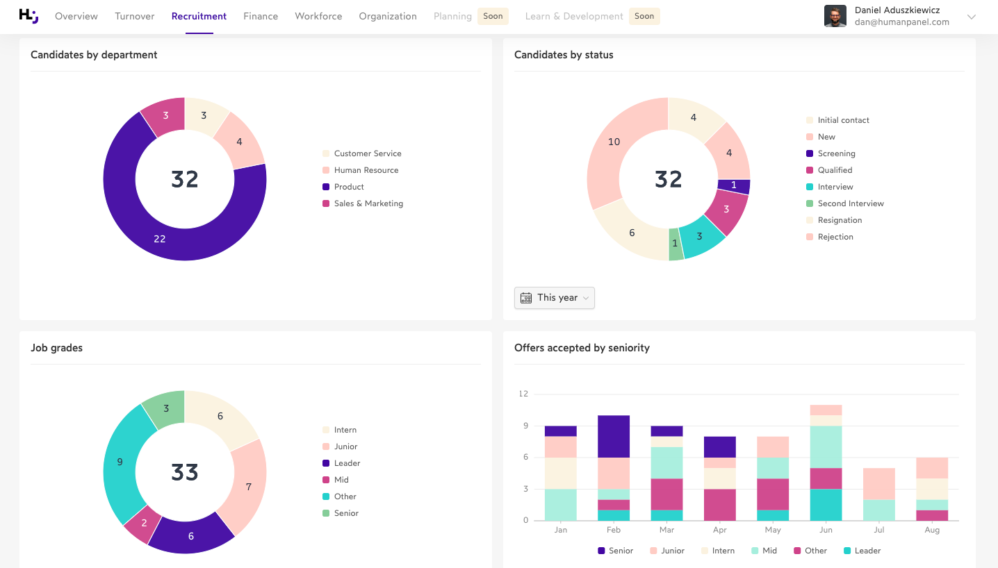
As for legal and ethical issues, you should obviously move within the legal framework, follow the GDPR policy, and make sure that the data you collect is secure. Then, try to ask yourself a question: is the data I gather crucial for my business? This question can help you judge if the information is truly necessary to collect. Obviously, you should invest in a data protection system to ensure the safety of data.
Question 7: My team is working remotely at the moment. Is it the right time to start people analytics?
The pandemic has reshaped the global talent market and initiated changes that are going to influence recruitment and retention processes for a long time. With global talent shortage, global market, and the rise of new working models, it’s just about time to introduce people analytics to your company.
The research shows that most employees want to continue working remotely to some extent. There is no “going back to the old times” – remote working has become a must for many companies, and an essential factor in being competitive in the marketplace.
Hence, you shouldn’t wait with introducing people analytics for the return to the office. In these unprecedented times, data can guide you and show you the right direction. The sooner you start working with data in HR, the better.
How to succeed in people analytics
The key to implementing a data-driven HR strategy successfully is to know the purpose of the strategy: Why you need people analytics in the first place? What are the pain points you want to respond to? Consider that people analytics should not only be viewed through the HR lens, but lead to the achievement of broader business goals.
Once you have defined your goal, think about the process that will get you there. One solution is to implement a simple and easy-to-use system, like the one developed by Human Panel. It gives you data analysis that is accessible to everyone – not just analysts. Anyone can gain insights and draw conclusions to make informed decisions immediately. All your information is secure and subject to full access control. To learn how much it costs and what benefits we can offer you, sign up for a free demo today – just fill in the form below.




